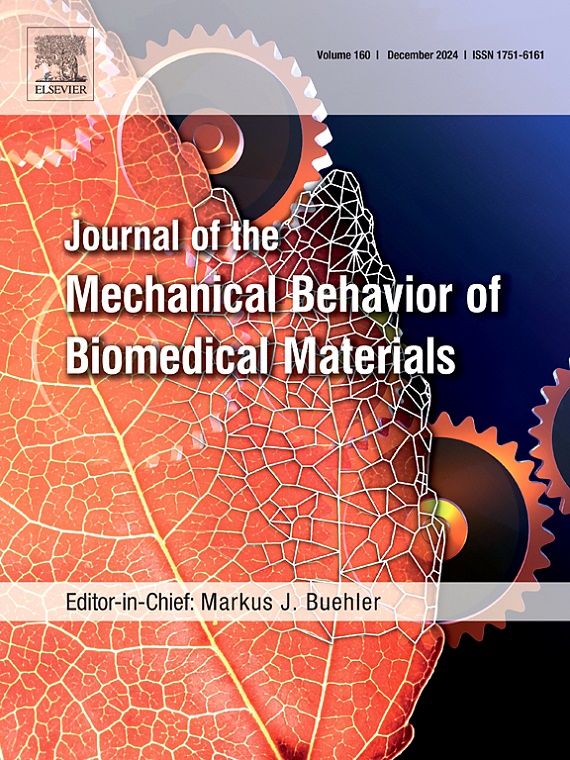A finite element simulation study on the superficial collagen fibril network of knee cartilage under cyclic loading: Effects of fibril crosslink densities
IF 3.5
2区 医学
Q2 ENGINEERING, BIOMEDICAL
Journal of the Mechanical Behavior of Biomedical Materials
Pub Date : 2025-06-14
DOI:10.1016/j.jmbbm.2025.107100
引用次数: 0
Abstract
Collagen, the most abundant protein in the human body, plays a pivotal role in the functioning of tissues such as cartilage of synovial joints. Mathematical modeling enables the more detailed study of the physical behavior of the network under load bearing. In this study, we aimed to develop a microscopic finite element (FE) modeling approach for the study of the stresses and strains of the collagen fibrils of cartilage under mechanical loading. This new approach enabled the two-dimensional modeling of a series of collagen meshwork at the microscopic level based on typical superficial collagen fibril structures of the articular cartilage. A collagen fibril network, a microscopic structure composed of 24 collagen fibrils, was designed to mimic the typical configuration found in the surface layer of cartilage. Twenty networks were developed, each representing one of three distinct crosslink density levels: high, medium, and low. This setup enabled us to investigate the effects of varying fibril connectivity on the network's morphology and its stress and strain responses under continuous biaxial tensile forces and cyclic loading, simulating the contact forces experienced by knee cartilage during walking. It was found that highly-crosslinked meshwork had greater stiffness than lower-crosslinked meshwork but with higher fibril strain under constant load, and that both the collagen meshwork and individual fibrils became stiffer with reduced deformation after several cycles. The current FE modeling approach provides new insights into the structure-function relationships of the collagen-like meshwork, with a specific focus on the unique role of fibril connectivity under mechanical loads. The current results suggest that collagen stiffening after several cyclic loading may lead to the embrittlement of collagen fibrils, altering the mechanical behavior of the cartilage. This study provides further evidence of the importance of the interfibrillar morphology of collagen meshwork in the mechanical behavior of cartilage. The current model illustrates the functional behavior of the collagen network and can be integrated into more comprehensive multiscale cartilage models that include additional components such as water and proteoglycans, thereby enabling a more complete representation of cartilage mechanics. Future research may utilize this collagen-centric model within broader, multi-phase frameworks to examine interactions between the collagen structure, fluids, and the proteoglycan network. These insights into fibril crosslink density-dependent mechanics may help elucidate early micro-mechanical changes occurring during osteoarthritis progression.
循环载荷下膝关节软骨表面胶原原纤维网络的有限元模拟研究:原纤维交联密度的影响
胶原蛋白是人体中含量最丰富的蛋白质,对滑膜关节软骨等组织的功能起着举足轻重的作用。数学建模可以更详细地研究网络在承载下的物理行为。在本研究中,我们旨在开发一种微观有限元(FE)建模方法来研究软骨胶原原纤维在机械载荷下的应力和应变。这种新方法使得基于关节软骨的典型表面胶原纤维结构的一系列胶原网络在微观水平上的二维建模成为可能。胶原原纤维网络是一种由24根胶原原纤维组成的微观结构,旨在模仿软骨表层的典型结构。共开发了20个网络,每个网络代表三种不同交联密度水平中的一种:高、中、低。这种设置使我们能够研究不同纤维连接对网络形态的影响,以及在连续双轴拉伸力和循环加载下的应力和应变响应,模拟膝关节软骨在行走过程中所经历的接触力。结果表明,高交联的网状结构刚度大于低交联的网状结构,但在恒载荷作用下,其纤维应变较高;多次循环后,胶原蛋白网状结构和单个原纤维均变硬,变形减小。目前的有限元建模方法为胶原样网络的结构-功能关系提供了新的见解,特别关注机械载荷下纤维连接的独特作用。目前的结果表明,多次循环加载后胶原硬化可能导致胶原原纤维脆化,改变软骨的力学行为。本研究进一步证明了胶原网状纤维间形态在软骨力学行为中的重要性。目前的模型说明了胶原网络的功能行为,并且可以集成到更全面的多尺度软骨模型中,包括额外的成分,如水和蛋白聚糖,从而能够更完整地表示软骨力学。未来的研究可能会在更广泛的多阶段框架中利用这种以胶原蛋白为中心的模型来研究胶原蛋白结构、流体和蛋白聚糖网络之间的相互作用。这些对纤维交联密度依赖力学的见解可能有助于阐明骨关节炎进展过程中发生的早期微力学变化。
本文章由计算机程序翻译,如有差异,请以英文原文为准。
求助全文
约1分钟内获得全文
求助全文
来源期刊

Journal of the Mechanical Behavior of Biomedical Materials
工程技术-材料科学:生物材料
CiteScore
7.20
自引率
7.70%
发文量
505
审稿时长
46 days
期刊介绍:
The Journal of the Mechanical Behavior of Biomedical Materials is concerned with the mechanical deformation, damage and failure under applied forces, of biological material (at the tissue, cellular and molecular levels) and of biomaterials, i.e. those materials which are designed to mimic or replace biological materials.
The primary focus of the journal is the synthesis of materials science, biology, and medical and dental science. Reports of fundamental scientific investigations are welcome, as are articles concerned with the practical application of materials in medical devices. Both experimental and theoretical work is of interest; theoretical papers will normally include comparison of predictions with experimental data, though we recognize that this may not always be appropriate. The journal also publishes technical notes concerned with emerging experimental or theoretical techniques, letters to the editor and, by invitation, review articles and papers describing existing techniques for the benefit of an interdisciplinary readership.
 求助内容:
求助内容: 应助结果提醒方式:
应助结果提醒方式:


